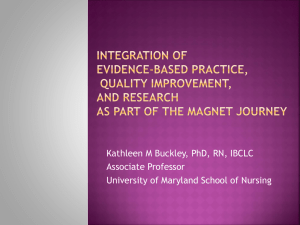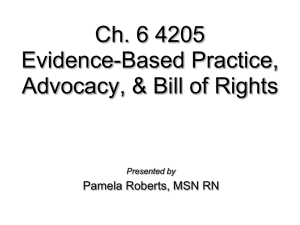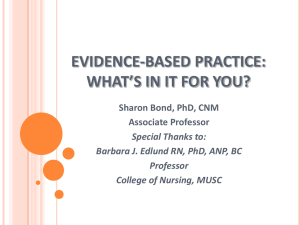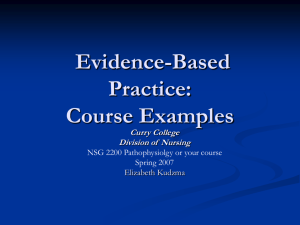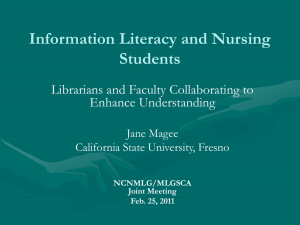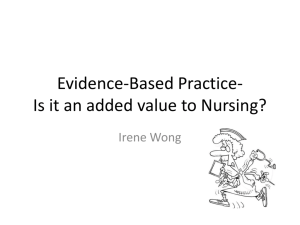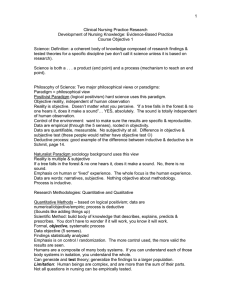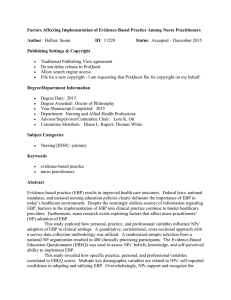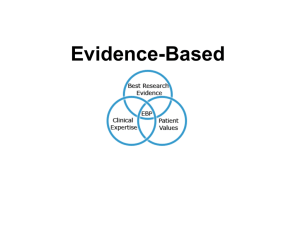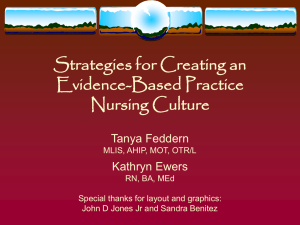Teaching Learning Strategies to Support EBP
advertisement
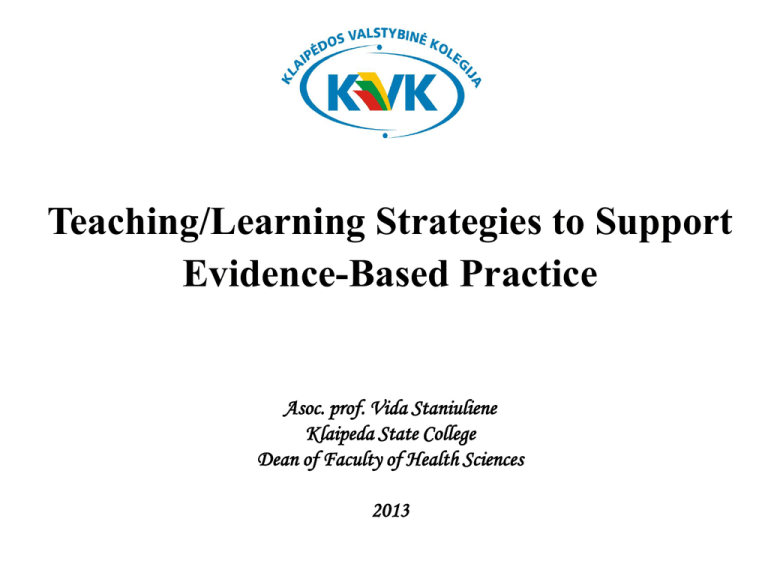
Teaching/Learning Strategies to Support Evidence-Based Practice Asoc. prof. Vida Staniuliene Klaipeda State College Dean of Faculty of Health Sciences 2013 The aim - To outline Teaching and Learning Strategies to support Evidance- Based practice (EBP). • To describe EBP processes and present strategies to integrate EBP into academic nursing education. • One aspect of evidence-based nursing education is the application of the research process (Emerson & Records,2008). • This approach includes application of the concepts related to qualitative and quantitative methods of inquiry to find and use the best evidence to promote optimal patient care in clinical practice areas. • According to Ciliska (2005), the process of achieving evidence-based nursing practice involves a series of successive steps: (a) identifying a clinical problem; (b) searching the literature for reviews and critical appraisals of relevant research; (c) creating change(s) in practice that is based on the specific evidence, including patient needs, and expertise of the advanced practice nurse; and (d) evaluating implemented changes for effectiveness. • Evidence-based practice is an expected core competency of all health care clinicians regardless of discipline. Use of evidence-based practice means integrating the best research with clinical expertise and patient values to achieve optimal health outcomes. Evidence-based practice requires nurses to access and appraise evidence rapidly before integrating it into clinical practice. • Nurses are required to adhere to accepted standards of practice and professional performance. These standards mandate the use of evidence-based interventions and the integration of research findings into practice. • EBP as 1 of 5 core competencies that every health care clinician should have, regardless of his or her discipline, to meet the needs of the 21st-century health care system. • Using EBP means integrating the best research with clinical expertise and patient values to achieve optimum care and participating in learning and research activities to the extent feasible. • Nurses must master competencies to rapidly access, evaluate, and integrate evidence into professional nursing practice (Table 1). 1. Ask a Clinical Question • There are 5 elements of a good clinical question, which help the students clarify the key elements of the question. These key elements can then be used as search terms to find empirical evidence in a variety of databases. Table 3 includes examples of PICOT questions of increasing complexity. 2. Search for the Best Evidence • A common strategy used by nursing faculty is to require students to find empirical evidence that identifies and supports nursing interventions implemented during clinical experiences. • To discuss the nursing interventions, levels of evidence, and the quality of resources used to gather the information (Table 4). • Important resources for students include orientation to library services; introduction to commonly used online databases, such as PubMed; and strategies for effective literature searches. • Accessing and retrieving information to promote EBP is best accomplished when active, hands-on experiences that encourage students for critical appraisal. 3. Critically Appraise the Evidence • Critical appraisal involves assessing and interpreting evidence by systematically considering the validity (truthfulness) and usefulness (clinical applicability) of the evidence to a particular context. • Online resources such as Google and Wikipedia provide instant information, evaluation of sources is important to ensure validity of the information used to guide nursing practice. 4. Integrate the Evidence With Clinical Expertise, Patient Preference, and Values • Opportunities to reinforce EBP often occur during clinical experiences. Clinical conferences provide students with time to discuss situations in which “real world” practice. • Collaborating with clinical managers, nurses, faculty staff and students is a good way to discuss clinical experiences, practice-based articles, reports of research studies, and newly published clinical guidelines in a stimulating environment. 5. Evaluate the Outcomes • In the clinical setting, faculty staff and tutors should call students’ attention to the importance of monitoring, evaluating, and reporting the outcome of the students’ interventions. • Did the intervention have the expected effect? Was the outcome consistent with results noted in previous clinical experiences and in the literature? If not, what may account for the discrepancy? What changes, if any, need to be made to achieve the intended results? These questions will yield important information to share with the clinical faculty, preceptor, and peers. • Using scenarios from clinical practice, students can learn develop clinical questions; collect information from a variety of sources, including clinical experiences, encounters with patients, and peer-reviewed journals, to answer questions; evaluate the strength and relevance of the evidence; and apply and integrate this information with previously learned knowledge. • Lack of value for research in practice has been identified as a key barrier to EBP. Integrating the skills necessary to develop EBP into clinical environment is an important part in developing positive attitudes toward EBP. • Skills are needed to access, appraise, and integrate evidence into practice and it is essential to professional nursing in the 21st century. • Challenges, Implications for Nursing Education and Management – CINEMA gives us an oppurtunity to update our knowledge and skills. Thank you for your attention!
